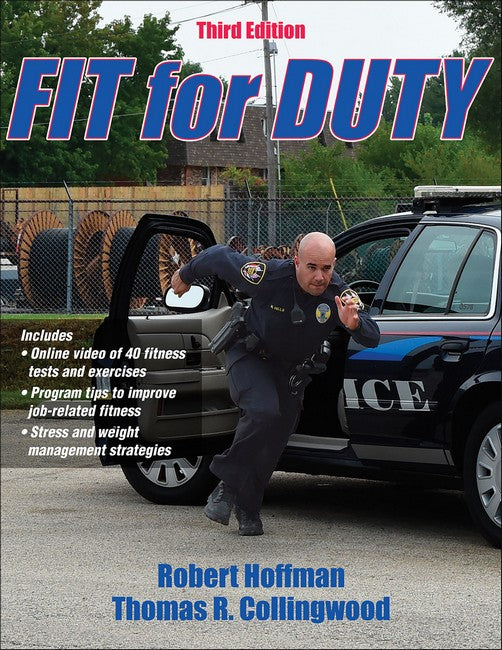Robert Hoffman, MS, retired from the U.S. Army as a lieutenant colonel in 1991. During his 22 years in the military, Hoffman completed assignments around the world. He commanded a brigade headquarters company in Germany, a ranger company in Vietnam, and a Special Forces SCUBA detachment at Fort Bragg, North Carolina. He also commanded the 4th Ranger Training Battalion at Fort Benning, Georgia, where in addition to working with rangers, Hoffman trained U.S. drug enforcement agents who were being deployed in South America. Hoffman spent three years as the director of training for the Army's Soldier Physical Fitness School and helped to develop the Army's Total Fitness program. He also spent four years as a professor in the department of physical education at West Point. While there, he was an assistant cross country and track coach and a junior varsity basketball coach. Hoffman was certified as a fitness instructor by the American College of Sports Medicine (ACSM) and as a master fitness trainer by the U.S. Army. He received a master's degree in physical education from Indiana University and was a member of the American Society of Law Enforcement Trainers. Hoffman was also the author of Running Together: The Family Book of Jogging, and he helped write the army's Physical Fitness Training field manual. Hoffman passed away in July 2016. Thomas R. Collingwood, PhD, has been involved in implementing law enforcement programs for 40 years. He developed and directed the continuing education division of the Cooper Institute for Aerobics Research, where he created the institute's police instructor course that has trained more than 10,000 police fitness coordinators. He also designed the FitForce national law enforcement fitness program. Collingwood has worked with more than 200 law enforcement agencies worldwide to design fitness programs and has conducted validation studies to define job-related fitness standards for 100 federal, state, and local law enforcement agencies. He is the author of 10 books and more than 100 publications in the field. Collingwood was a military policeman with the U.S. Army, a police psychologist with the Dallas Police Department, and a training director for the Kentucky Department of Justice. He has served as the national fitness director for the American Society of Law Enforcement Trainers and as a special advisor on law enforcement fitness to the President's Council on Physical Fitness and Sports and the International Association of Chiefs of Police (IACP). He also was an advisor for the redesign of the U.S. Army's Physical Readiness program. Collingwood holds a master's degree in exercise science from the University of Kentucky and a doctorate in psychology from the University of Buffalo, and he is a certified health and fitness director with the American College of Sports Medicine. The IACP, U.S. Drug Enforcement Administration, U.S. Marshals Service, and U.S. Secret Service have all recognized Collingwood for his work in the field of law enforcement fitness. He was the recipient of the Healthy American Fitness Leaders award presented by the President's Council on Physical Fitness and Sports and the National Jaycees. Collingwood resides with his wife, Gretchen, in Richardson, Texas.
Request Academic Copy
Please copy the ISBN for submitting review copy form
Description
Part I. Assessing Your Fitness Chapter 1. What Does Fitness Mean to an Officer's Physical Readiness? History of Physical Fitness Components of Physical Fitness Physical Readiness for the Job Job Relatedness of Physical Fitness Tests and Standards Maintaining a Professional Image Conclusion Chapter 2. What Does Fitness Mean to an Officer's Health and Well-Being? Societal Fitness and Health Officers' Fitness and Health Benefits of a Fitness Program Conclusion Chapter 3. How Do You Start Being Active? Exercise Versus Physical Activity Preparing for Activity Making the Commitment Creating a Plan Following the Plan Conclusion Chapter 4. How Fit Are You? Importance of Testing Agency Physical Performance Testing Fitness Standards Validation for Law Enforcement Assessing Your Fitness Level Using Your Test Results Conclusion Part II. Training for Fitness Chapter 5. Principles of Exercise Principle 1: Regularity Principle 2: Recovery Principle 3: Reversibility Principle 4: Overload Principle 5: Progression Principle 6: Balance Principle 7: Variety Principle 8: Specificity Principle 9: Adaptation Principle 10: Individuality Principle 11: Moderation Fitness Training Myths Conclusion Chapter 6. Cardiorespiratory Endurance What Is Cardiorespiratory Endurance? Designing Your Cardiorespiratory Program Environmental Guidelines Warming Up and Cooling Down Conclusion Chapter 7. Resistance Training What Are Muscular Strength and Muscular Endurance? Developing Muscular Strength Designing Your Resistance Training Program Resistance Training Tips Resistance Bands Partner-Resisted Exercises Developing a Calisthenics Training Plan Scheduling Exercise Conclusion Chapter 8. Flexibility What Is Flexibility? Designing Your Flexibility Program Flexibility Training Tips Conclusion Chapter 9. Anaerobic Fitness What Is Anaerobic Fitness? Designing Your Anaerobic Running Program Training for the 300-Meter Run Designing Your Lower-Body Explosive Power Program Designing Your Agility Running Program Anaerobic Fitness Training Tips Conclusion Chapter 10. Nontraditional Training Stability Ball Exercises Medicine Ball Exercises Combination or Multijoint Exercises Circuits Plyometrics Balance Pilates Yoga Conclusion Part III. Managing the Lifestyle Components of Fitness Chapter 11. Understanding Diet and Nutrition Classes of Nutrients Basic Nutritional Goals Conclusion Chapter 12. Controlling Weight What Is Weight Management? Principles of Weight Loss Developing a Weight-Loss Plan Planning for Weight Management and Good Nutrition Using an Eating Checklist Conclusion Chapter 13. Dealing With Stress What Is Stress? Handling Stress Tips for Reducing Stress Conclusion Chapter 14. Quitting Smoking What's So Bad About Cigarettes? Impact of Smoking on Performance Effects of Secondhand Smoke Benefits of Quitting How to Quit Conclusion Chapter 15. Preventing Substance Abuse Abuse and Addiction Alcohol Drugs Performance-Enhancing Supplements and Steroids Conclusion Part IV. Maintaining Your Fitness Chapter 16. Setting Fitness Goals Determining Your Fitness Goals Profiling Your Fitness Setting Goals Using CHAMPS Goal-Setting Tips Creating Goals for Various Fitness Levels Using a Goal-Setting Worksheet Conclusion Chapter 17. Motivating Yourself to Be Fit The Way We Change Identifying Common Roadblocks Acting to Avoid Slipping and Dropping Out Reviewing Your Performance Rewarding Yourself Conclusion

